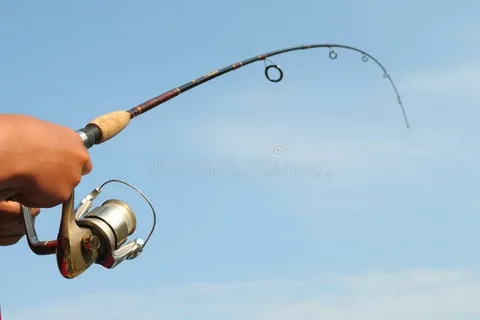#AnglingTrends
Explore tagged Tumblr posts
Text
Fishing Rods Market trends analysis shows key growth factors in global angling demand

The Fishing Rods Market is undergoing a dynamic transformation, fueled by a growing global interest in recreational fishing, sustainability, and outdoor lifestyles. As more consumers seek engaging and mindful outdoor experiences, angling has reemerged as a popular pastime across demographics and geographies. This surge in demand is not only influencing product innovation but also reshaping how manufacturers approach materials, marketing, and technology in the fishing rods market.
Rising Popularity of Recreational Fishing as a Lifestyle Choice
One of the strongest drivers of growth in the fishing rods market is the increasing popularity of recreational fishing. More people around the world are turning to fishing as a hobby that promotes relaxation, sustainability, and connection with nature. This is particularly evident in post-pandemic consumer behavior, where outdoor activities saw a significant upswing as people sought safe and socially distanced leisure options.
1. Outdoor Recreation Boom
The shift toward outdoor activities has directly boosted sales of fishing gear, especially rods designed for beginners and hobbyists. Countries with rich natural water bodies like the U.S., Canada, Australia, and Nordic nations have reported an increase in fishing license applications and equipment sales, pointing to broader lifestyle changes.
2. Family-Oriented and Social Engagement
Fishing is increasingly being positioned as a family-friendly or social activity that promotes well-being and bonding. This perception shift has expanded the target market for fishing rods to include not just seasoned anglers, but also families, youth, and occasional hobbyists.
Product Innovation: Materials, Technology, and Design
The fishing rods market is seeing a wave of product innovation to meet the demands of new and experienced anglers alike. Brands are competing on durability, portability, sustainability, and user-friendly features.
1. Lightweight and High-Strength Materials
Manufacturers are embracing advanced materials like carbon fiber and graphite composites to make rods lighter and more durable. These materials enhance the angling experience, offering greater sensitivity and casting distance while reducing fatigue during long fishing sessions.
2. Modular and Travel-Friendly Designs
The demand for portability has led to the rise of telescopic and modular rods that are easy to carry and assemble. This trend is especially prominent among travelers, campers, and backpackers who want compact, multi-purpose fishing tools.
3. Smart Fishing Rods and IoT Integration
Technology is beginning to influence traditional fishing tools. Some brands are introducing smart rods equipped with sensors that track casting distance, detect fish movements, and sync with mobile apps. These features appeal particularly to tech-savvy consumers and younger anglers.
Market Expansion and E-Commerce Influence
Another growth factor for the fishing rods market is the expansion into emerging markets and the rise of digital sales channels.
1. Penetration in Emerging Economies
As disposable incomes increase in countries like India, Brazil, and parts of Southeast Asia, recreational activities including fishing are becoming more accessible. Government initiatives promoting ecotourism and outdoor sports further support this trend.
2. E-Commerce and Direct-to-Consumer Sales
Online platforms have made fishing rods and accessories more accessible than ever. Brands are using digital marketing, influencer promotions, and subscription models to reach consumers directly. E-commerce also enables product comparisons, reviews, and detailed specifications, enhancing the buying experience for new users.
Environmental Awareness and Sustainable Practices
Environmental consciousness is shaping the direction of the fishing rods market, with consumers preferring brands that emphasize sustainability.
1. Eco-Friendly Materials
Some manufacturers are incorporating recycled or biodegradable materials in rod handles and packaging. Bamboo rods, for example, are regaining popularity for being both sustainable and effective.
2. Ethical Angling Campaigns
Brands are supporting catch-and-release campaigns and marine conservation efforts to align with the values of modern anglers. Educated consumers are more likely to support companies that show environmental responsibility.
Competitive Landscape and Consumer Loyalty
As competition intensifies, brand loyalty and trust play a larger role in consumer decision-making. Product warranties, customization options, and after-sales support are critical differentiators.
1. Niche Targeting and Custom Rods
Custom rods tailored to specific types of fishing—fly fishing, deep-sea fishing, freshwater, or saltwater—are gaining traction. Brands are offering personalization in terms of grip material, rod length, and action type.
2. Focus on Experience Over Price
Consumers today are driven by experience rather than cost alone. A well-balanced rod that enhances their fishing trip is worth the premium, especially if backed by good service and quality assurance.
Conclusion
The fishing rods market is experiencing robust growth, thanks to rising recreational fishing interest, product innovations, sustainable practices, and digital sales expansion. As the market evolves, manufacturers and retailers must stay aligned with consumer values, lifestyle trends, and regional demand patterns. By focusing on quality, innovation, and environmental consciousness, players in the fishing rods market can capture long-term consumer loyalty and stay ahead of global competition.
#FishingRodsMarket#AnglingTrends#OutdoorRecreation#SmartFishingGear#FishingInnovation#EcoFriendlyFishing#RecreationalFishing#FishingGear#TackleTech#FishingLife#FishingRodTrends#GlobalFishingMarket
0 notes